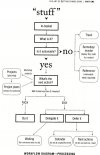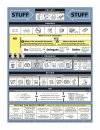Julie Jones
Registered
GTD talks about keeping working modes separate (capture, clarify, organize, reflect, engage), and shows how this leads to more efficient use of time and the ability to get more done. I would like to start a discussion based on my observations from personal GTD use and extensive reading about the subject.
Engage - it is very easy to see how choosing one action from the Next Actions list and working on it to completion with no distractions will be the most effective way to get things done. The one exception is when an idea pops into your head during that work and you want to follow the rule of capture everything as soon as it occurs to you. I believe that the most efficient way to do that is with some sort of voice capture. The simpler the better, and the idea is to just capture the idea and not think about it in any other way. (For me, "Hey Siri, email nirvana my new idea" does the trick.) If the capture is quick and requires no real thought it doesn't distract from the current action being done.
Capture - @DavidAllen talks about this at length, especially when he discussed doing an initial capture with his clients and how there is a huge tendency to start to sort physical things or do something more than just collect. I have seen something similar when reviewing various tools and seeing comments about how some customers are very vocal about wanting a tool that allows them to capture an item with all kinds of additional information using a natural language.
For example: new task do something area:school context:computer due date:10-22-2022.
My belief is that this make capturing take longer, and if you are in the middle of doing something else, capturing with additional information is more likely to make your mind switch gears.
Reflecting - I don't have an very specific thoughts, except that during a weekly review some of the steps should be kept separate and done as quickly as possible because they are just work modes in the context of a review.
Clarifying - I understand clarifying from the perspective of emptying the inbox quickly and not spending more than 2 minutes on any one item. I wonder about the project loop on the GTD workflow processing diagram. What is the clarifying part and what is the organizing part.

Organizing - This is what I have been pondering the most and would really like to hear everyone's opinions about. Looking at the advanced workflow diagram,

one can see how the lines are drawn between clarifying and organizing. It seems like clarifying is putting items in the correct organizational bucket. Normally, people talked about organizing something, say a silverware drawer, they mean putting the items in the correct section of the drawer.
If clarifying is already putting things in the correct "category" then what is the definition of the organizing step?
Am I right in thinking that it is adding more information after the sorting is complete?
My current thought after rereading GTD and Making it all work, is that clarify is to decide what it is and which category it belongs to quickly to empty the inbox and that organizing it is the more detailed process of adding contexts, notes, deciding which area, whether it needs a due date, etc.?
Then my brain starts thinking that part of a review is looking at everything and deciding if all the information is still correct (verifying the organization).
I seem to just get caught in a big mental loop. I could be overthinking it, but as a software engineer that is how my mind works. (What would my perfect GTD app look like?)
So that leaves me with the question of how to draw a concrete line between clarifying and organizing.
Engage - it is very easy to see how choosing one action from the Next Actions list and working on it to completion with no distractions will be the most effective way to get things done. The one exception is when an idea pops into your head during that work and you want to follow the rule of capture everything as soon as it occurs to you. I believe that the most efficient way to do that is with some sort of voice capture. The simpler the better, and the idea is to just capture the idea and not think about it in any other way. (For me, "Hey Siri, email nirvana my new idea" does the trick.) If the capture is quick and requires no real thought it doesn't distract from the current action being done.
Capture - @DavidAllen talks about this at length, especially when he discussed doing an initial capture with his clients and how there is a huge tendency to start to sort physical things or do something more than just collect. I have seen something similar when reviewing various tools and seeing comments about how some customers are very vocal about wanting a tool that allows them to capture an item with all kinds of additional information using a natural language.
For example: new task do something area:school context:computer due date:10-22-2022.
My belief is that this make capturing take longer, and if you are in the middle of doing something else, capturing with additional information is more likely to make your mind switch gears.
Reflecting - I don't have an very specific thoughts, except that during a weekly review some of the steps should be kept separate and done as quickly as possible because they are just work modes in the context of a review.
Clarifying - I understand clarifying from the perspective of emptying the inbox quickly and not spending more than 2 minutes on any one item. I wonder about the project loop on the GTD workflow processing diagram. What is the clarifying part and what is the organizing part.

Organizing - This is what I have been pondering the most and would really like to hear everyone's opinions about. Looking at the advanced workflow diagram,

one can see how the lines are drawn between clarifying and organizing. It seems like clarifying is putting items in the correct organizational bucket. Normally, people talked about organizing something, say a silverware drawer, they mean putting the items in the correct section of the drawer.
If clarifying is already putting things in the correct "category" then what is the definition of the organizing step?
Am I right in thinking that it is adding more information after the sorting is complete?
My current thought after rereading GTD and Making it all work, is that clarify is to decide what it is and which category it belongs to quickly to empty the inbox and that organizing it is the more detailed process of adding contexts, notes, deciding which area, whether it needs a due date, etc.?
Then my brain starts thinking that part of a review is looking at everything and deciding if all the information is still correct (verifying the organization).
I seem to just get caught in a big mental loop. I could be overthinking it, but as a software engineer that is how my mind works. (What would my perfect GTD app look like?)
So that leaves me with the question of how to draw a concrete line between clarifying and organizing.
